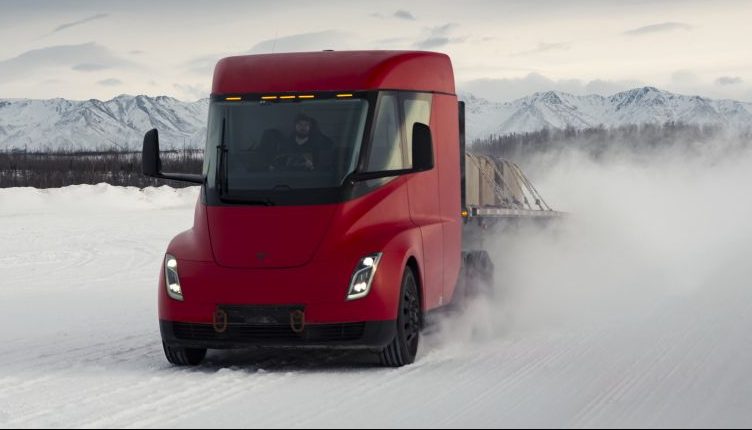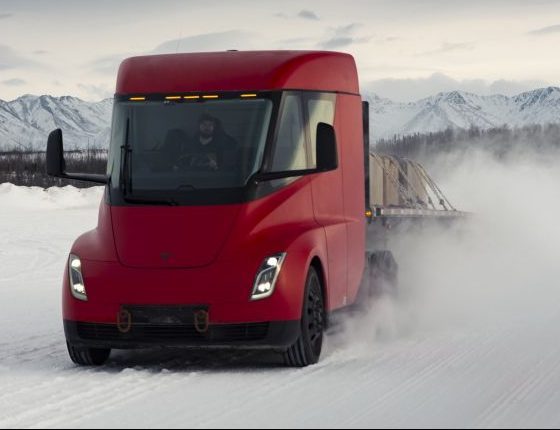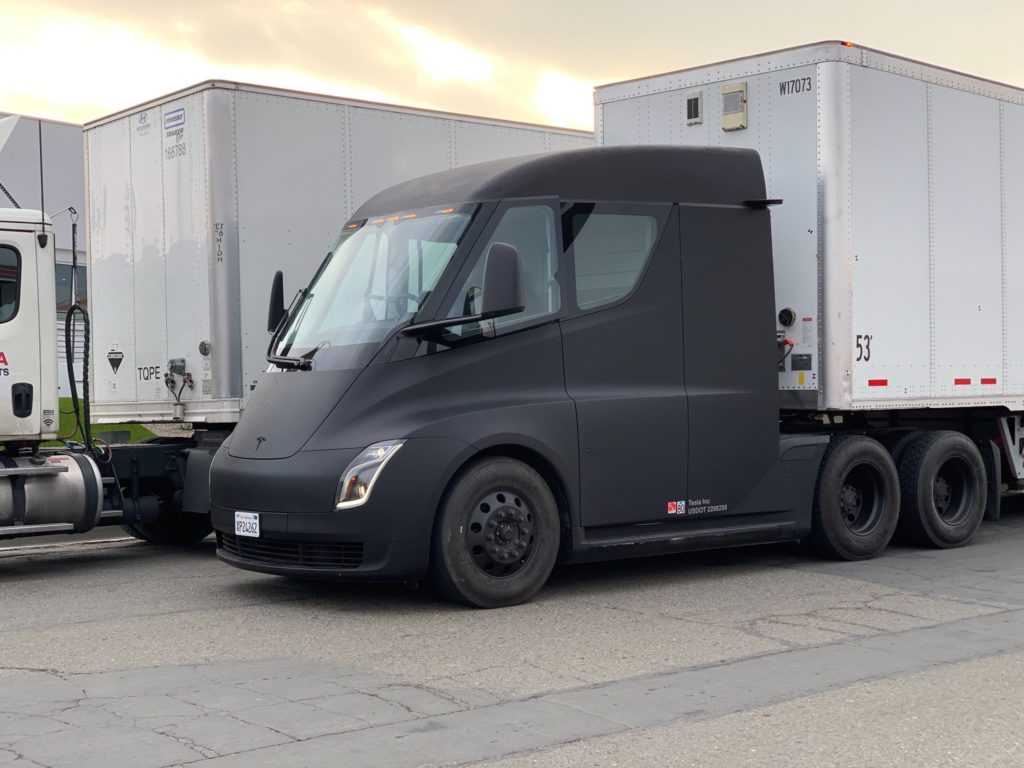

News
The Tesla Semi’s butterfly effect will change the face of heavy-duty freight routes
In a recent interview, Auke Hoekstra, a researcher at Eindhoven University of Technology and an electric vehicle expert, explained how battery-electric trucks like the Tesla Semi could end up dominating heavy-duty freight routes in regions like Europe. According to the EV expert, weight and range limitations that are usually associated with electric vehicles may very well be quite irrelevant when it comes to the real-world use of the electric long-haulers.
While addressing questions from Clean Energy Wire, Hoekstra explained that skeptics of vehicles like the Tesla Semi often take the hardest business case that a diesel truck is able to manage. An example of this is a multi-day trip with a team of two drivers who cover thousands of kilometers in one trip. The EV expert explained that while traditional diesels still hold an advantage against their battery-electric competition in this scenario, this edge disappears when one looks at the greater trucking market.
“My research in the Netherlands has revealed that 80% of trucks – even the really big rigs, the semis – travel 750 kilometers per day at the very most, and many cover far shorter distances. That’s because if you want to cover more kilometers, things become very expensive very quickly, because you have to pay overtime, etcetera. So, in general, you can’t make a driver do more than 750 kilometers per day. Therefore, this is the range you have to hit with about 80 percent of trucks.

“Additionally, almost all trucks return to base at the end of the day – which creates ideal conditions for charging. We still have this romantic idea that truckers are on the road for weeks on end, away from home. But this scenario has become relatively rare. Most truckers simply move stuff from Rotterdam port to Venlo, halfway to Germany’s Ruhr area, to take an example from home… Many truckers do this sort of trip a couple of times per day, and then return home. So, you can charge the vehicle overnight at a default location. This means you don’t have a chicken and egg problem – you can arrange for the infrastructure and for the truck at the same time,” the EV expert remarked.
Interestingly enough, Elon Musk has recently remarked that Tesla is looking to release the Semi with a range that falls well within Hoekstra’s numbers. While speaking at the European Battery Conference, Musk stated that he believes it is feasible to achieve 800 kilometers of range for the Semi quite easily, and he also sees a path, over time at least, for the Class 8 truck to achieve an even more impressive 1,000 kilometers per charge. Such numbers can go a long way towards shifting the market’s perception of all-electric long-haulers and their limitations. Hoekstra, for his part, noted that such a scenario has already happened before with the original Tesla Roadster.

“I do remember that in the car market, things really changed when the Roadster hit the market. That really changed the conversation. It changed the whole perception of electric vehicles. The conventional wisdom back then was that you can only use them on short distances in the city. And suddenly this car appeared, and everything was possible.
“Within the next couple of years, we’ll see the first Tesla semi-trucks on the road. This will have a similarly huge impact on the conversation about electric trucks. You can just point to it and say: “Look, it’s moving there, and it is doing 800 kilometers.” Suddenly, all those people who say ‘it cannot be done’ within truck companies will hear their boss replying: ‘Well, our competitor can do it – so you will have to do it, too.’” Hoekstra said.
What’s quite remarkable is that this is not even the most exciting part of the Semi’s butterfly effect on the trucking sector. If the Tesla Semi finds solid footing in the trucking market in the same way the Model 3 found a good niche among premium midsize sedan buyers, a “Tesla Effect” of sorts could happen on the trucking market. This could come in the form of other battery-electric trucks being developed for the long-haul market. This should, in turn, result in a massive innovation push from several truck makers, similar to what is happening now with companies like Tesla, Lucid, Rivian, and veterans like Ford and GM in the consumer EV segment.

News
Tesla FSD fleet is nearing 7 billion total miles, including 2.5 billion city miles
As can be seen on Tesla’s official FSD webpage, vehicles equipped with the system have now navigated over 6.99 billion miles.

Tesla’s Full Self-Driving (Supervised) fleet is closing in on almost 7 billion total miles driven, as per data posted by the company on its official FSD webpage.
These figures hint at the massive scale of data fueling Tesla’s rapid FSD improvements, which have been quite notable as of late.
FSD mileage milestones
As can be seen on Tesla’s official FSD webpage, vehicles equipped with the system have now navigated over 6.99 billion miles. Tesla owner and avid FSD tester Whole Mars Catalog also shared a screenshot indicating that from the nearly 7 billion miles traveled by the FSD fleet, more than 2.5 billion miles were driven inside cities.
City miles are particularly valuable for complex urban scenarios like unprotected turns, pedestrian interactions, and traffic lights. This is also the difference-maker for FSD, as only complex solutions, such as Waymo’s self-driving taxis, operate similarly on inner-city streets. And even then, incidents such as the San Francisco blackouts have proven challenging for sensor-rich vehicles like Waymos.
Tesla’s data edge
Tesla has a number of advantages in the autonomous vehicle sector, one of which is the size of its fleet and the number of vehicles training FSD on real-world roads. Tesla’s nearly 7 billion FSD miles then allow the company to roll out updates that make its vehicles behave like they are being driven by experienced drivers, even if they are operating on their own.
So notable are Tesla’s improvements to FSD that NVIDIA Director of Robotics Jim Fan, after experiencing FSD v14, noted that the system is the first AI that passes what he described as a “Physical Turing Test.”
“Despite knowing exactly how robot learning works, I still find it magical watching the steering wheel turn by itself. First it feels surreal, next it becomes routine. Then, like the smartphone, taking it away actively hurts. This is how humanity gets rewired and glued to god-like technologies,” Fan wrote in a post on X.
News
Tesla starts showing how FSD will change lives in Europe
Local officials tested the system on narrow country roads and were impressed by FSD’s smooth, human-like driving, with some calling the service a game-changer for everyday life in areas that are far from urban centers.

Tesla has launched Europe’s first public shuttle service using Full Self-Driving (Supervised) in the rural Eifelkreis Bitburg-Prüm region of Germany, demonstrating how the technology can restore independence and mobility for people who struggle with limited transport options.
Local officials tested the system on narrow country roads and were impressed by FSD’s smooth, human-like driving, with some calling the service a game-changer for everyday life in areas that are far from urban centers.
Officials see real impact on rural residents
Arzfeld Mayor Johannes Kuhl and District Administrator Andreas Kruppert personally tested the Tesla shuttle service. This allowed them to see just how well FSD navigated winding lanes and rural roads confidently. Kruppert said, “Autonomous driving sounds like science fiction to many, but we simply see here that it works totally well in rural regions too.” Kuhl, for his part, also noted that FSD “feels like a very experienced driver.”
The pilot complements the area’s “Citizen Bus” program, which provides on-demand rides for elderly residents who can no longer drive themselves. Tesla Europe shared a video of a demonstration of the service, highlighting how FSD gives people their freedom back, even in places where public transport is not as prevalent.
What the Ministry for Economic Affairs and Transport says
Rhineland-Palatinate’s Minister Daniela Schmitt supported the project, praising the collaboration that made this “first of its kind in Europe” possible. As per the ministry, the rural rollout for the service shows FSD’s potential beyond major cities, and it delivers tangible benefits like grocery runs, doctor visits, and social connections for isolated residents.
“Reliable and flexible mobility is especially vital in rural areas. With the launch of a shuttle service using self-driving vehicles (FSD supervised) by Tesla in the Eifelkreis Bitburg-Prüm, an innovative pilot project is now getting underway that complements local community bus services. It is the first project of its kind in Europe.
“The result is a real gain for rural mobility: greater accessibility, more flexibility and tangible benefits for everyday life. A strong signal for innovation, cooperation and future-oriented mobility beyond urban centers,” the ministry wrote in a LinkedIn post.
News
Tesla China quietly posts Robotaxi-related job listing
Tesla China is currently seeking a Low Voltage Electrical Engineer to work on circuit board design for the company’s autonomous vehicles.

Tesla has posted a new job listing in Shanghai explicitly tied to its Robotaxi program, fueling speculation that the company is preparing to launch its dedicated autonomous ride-hailing service in China.
As noted in the listing, Tesla China is currently seeking a Low Voltage Electrical Engineer to work on circuit board design for the company’s autonomous vehicles.
Robotaxi-specific role
The listing, which was shared on social media platform X by industry watcher @tslaming, suggested that Tesla China is looking to fill the role urgently. The job listing itself specifically mentions that the person hired for the role will be working on the Low Voltage Hardware team, which would design the circuit boards that would serve as the nervous system of the Robotaxi.
Key tasks for the role, as indicated in the job listing, include collaboration with PCB layout, firmware, mechanical, program management, and validation teams, among other responsibilities. The role is based in Shanghai.
China Robotaxi launch
China represents a massive potential market for robotaxis, with its dense urban centers and supportive policies in select cities. Tesla has limited permission to roll out FSD in the country, though despite this, its vehicles have been hailed as among the best in the market when it comes to autonomous features. So far, at least, it appears that China supports Tesla’s FSD and Robotaxi rollout.
This was hinted at in November, when Tesla brought the Cybercab to the 8th China International Import Expo (CIIE) in Shanghai, marking the first time that the autonomous two-seater was brought to the Asia-Pacific region. The vehicle, despite not having a release date in China, received a significant amount of interest among the event’s attendees.








